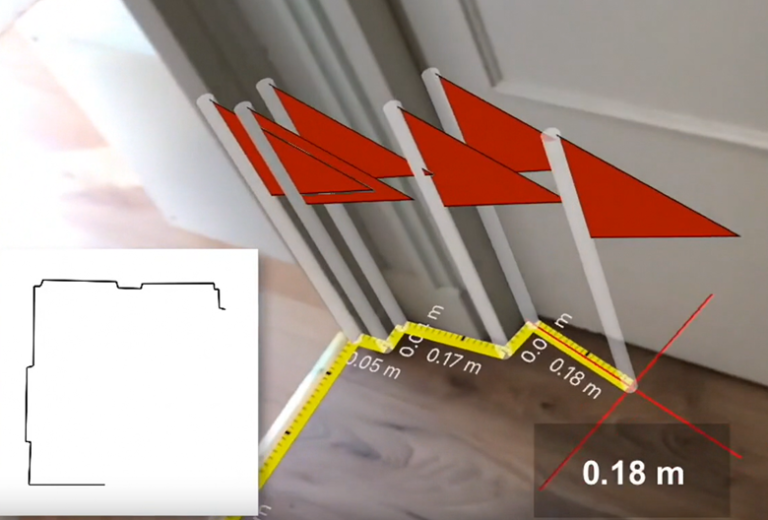On an iPhone, of course.
If you're using a tape measure, sketching, or AutoCAD to create your floor plan, you're too busy.
The fastest and easiest way to create a floor plan is to pull out your iPhone and scan the interior using one of the many apps available for this purpose. To demonstrate, I pulled out my iPhone 12 Max with Polycam installed and scanned the interior of a 600 sq ft hallway outside my office. It took less than 5 minutes. I literally pressed a button and in no time I had a floor plan.
It's very easy.

This floor plan took me less than five minutes to create using my iPhone and the Polycam app. It would have taken half a day using a tape measure and AutoCAD.
One scanning tutorial describes it as like painting a wall, but with a camera as the paintbrush and a roller brush that can reach up to 15 feet (4.5 meters) high. Set the app to video mode and “paint” up and down along the wall as you move down the hallway. Small walls can be covered with a few strokes up and down. As you scan, Polycam detects edges and displays them in the camera view. Lines form and follow you as you walk down the hallway. The app determines where the wall meets the floor and ceiling, even if they're obscured by cabinets, potted plants, tables, and office clutter. Polycam doesn't tout its AI, but this is artificial intelligence (AI) in the truest sense. But the magic happens here: walls start and finish, doors and windows are detected, and most, if not all, of the irrelevant filtering happens.
In the end, you not only have a floor plan but a 3D model, which is a truly amazing feat.
Well, it's not perfect. It's not accurate to ±1/16 inch like you can measure with a tape measure. More on that later. There might be artifacts to remove. There's bound to be some cleanup to do. That might take another 10 minutes. But let's say the traditional tape measure/sketch/CAD workflow would take you half a day. With a phone app, you can rest most of your morning.
I used Polycam and Canvas to scan rooms to create floor plans. Not a month goes by without a new app. All use the built-in LiDAR in the Apple iPhone, but have different usage plans and rates, from free to a per square foot fee to an all-you-can-eat buffet. I chose the unlimited use all-you-can-eat buffet for $99.99, which is convenient and cost-effective. Canvas will quote you a price per square foot of the scanned floor space before you submit, but the price per square foot of the model you create can vary significantly. My initial quote was $309, but the final bill was over $500 for a roughly 2,000 square foot single-story home.
The Polycam stands out with its X-ray vision, which can sense and complete entire sections of walls, making it perfect for creating floor plans using the app's “Room” setting. But if you want it to recognize and model everything — furniture, doorknobs, bookshelves, desks, computers — use the default LiDAR setting. The camera view then maps the room not with lines, but with a mesh of triangles, like a fine net that covers everything. If you're a real estate agent who wants to stage homes and showcase them with a video inventory of art, or any other application that requires more than just measuring and recording walls, you'll want to use the LiDAR setting.
In either case, you send the scan to Polycam for processing and within the hour you’ll have the result – either a floor plan or a full color 3D model.
Speaking of your tape measure, don't throw it away. You'll need it to verify your dimensions. Canvas estimates a 1-2% tolerance, or about 2 ½ inches for a 10-foot wall. Contractors will not be able to cut to within this tolerance.
For a “quick and easy” floor plan that still looks better than hand-drawn, nothing beats a scan. When quoting for flooring or carpeting, add an extra 5% to cover any inaccuracies. If you're using your floor plans in a real estate brochure and are scared of being sued by a client whose closets are 4% smaller, add a disclaimer such as “AI measurements based on scan. All values should be verified.” Your clients will be impressed with your use of technology.
Here are some apps that will help you easily create floor plans on your iPhone.
CamToPlan is an even simpler concept, and easier to understand for those who can't imagine a future without their trusty tape measure. With Cam2Plan, you scan and a virtual tape measure appears. Instead of scanning up and down a wall, you point the camera at the floor. The virtual tape measure unfolds, and you click anywhere on the screen to lock each section of the wall. This makes a simple scan in 3D even simpler in 2D. Some of the points I measured were off, and I wished I could snap to right angles, but that might work against the simplicity CamToPlan strives for. CamToPlan is free for the first month, then switches to a monthly subscription for $19.99.
Other scanners you can use for floor plans:

